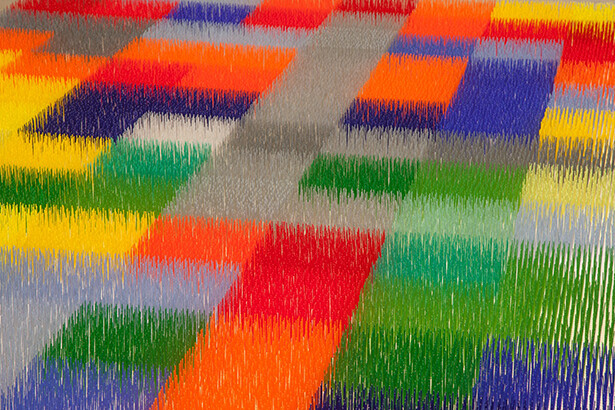November 8, 2015–February 21, 2016
Neuberger Museum of Art
735 Anderson Hill Road
Purchase
New York 10577
T +914 251 6100
www.neuberger.org
Liza Lou’s monumental shimmering work Color Field—on view at the Neuberger Museum of Art, Purchase College, SUNY from November 8 through February 2 as part of the exhibition Liza Lou: Color Field and Solid Grey—is the artist’s largest sculpture to date. Blanketing the Museum’s gallery floor, the 1400-square-foot work, with its thousands of blades of grass (small stainless steel wires) arranged in brilliant squares of color (over two million tiny glass beads are strung on the wires), took four years, a team of 30 Zulu women artisans in Durban, South Africa, and hundreds of volunteers in Westchester County to assemble, all under the artist’s direction.
Although its name seems to pay homage to the original Color Field painters of the 1950s and ’60s, such as Mark Rothko and Helen Frankenthaler, Liza Lou, a MacArthur Foundation prize-winning artist, emphasized that the title is meant to be read as more open-ended. “I titled the work Color Field for the obvious associations to both an art movement and the fact that it is indeed a physical field of color,” she said in a recent conversation with the Museum. “However, I think of the work as a meditation on process as harvest and growth, as well as color as subject matter.”
Walking alongside the periphery of this luminous field, the colors blend and blur slightly in a moiré effect. “It becomes a physical experience,” says Lou, whose first and smaller version of Color Field was displayed at the Museum of Contemporary Art San Diego in 2013. Lou also describes Color Field as a celebration of the handmade. “There is a kind of apotheosis of the human hand,” she says. “Color Field started with a very simple activity, that of threading glass beads onto pieces of stainless steel wire, but there is a tipping point where simplicity yields to something larger, not only in scale, but in depth and complexity, and for me, that’s where things start to get interesting.” The effect can be thrilling.
The exhibition also includes Lou’s Solid Grey and Color/White canvases, a series of “paintings” woven out of glass beads. “Every canvas is a solid color,” says Lou. “Beads are a dense material; they are uniform and perfectly round, and stitched in the same methodical way. But each woven strip comes back with the imprint of the person who wove it, so there are subtle variances. What emerges is a kind of patina of process.”
Liza Lou: Color Field and Solid Grey is organized by the Neuberger Museum of Art and made possible with generous support from Donna and Marvin Schwartz. Additional support is provided by ArtsWestchester, with support from Westchester County government.
Programs in conjunction with the exhibition:
Saturday, November 14
Save the date! Special family program
Come celebrate the opening of the dazzling exhibition Liza Lou: Color Field and Solid Grey with family-friendly activities! Enjoy a glass art workshop and fun tours designed especially for kids!
Tickets: Free for Neuberger Family Circle Members and above. Non-members: 10 USD per child 18 and under, adults free.
Wednesday, January 27, 12:30pm
“Rebirths and Transformations: Spirituality and the Art of Liza Lou”
NMA Study
Eleanor Heartney, a contributing editor to Art in America and Artpress and author of several books, including Art & Today, investigates Liza Lou’s relationship to religion and the way that her communal process of creation reflects her evangelical upbringing.
Tickets: Complimentary to Purchase College students, staff, and faculty, as well as Neuberger Museum of Art Circle Level Members. Event admission: 10 USD.
Wednesday, February 17, 6:30pm
“Handmade: Craft, Material, and Skill in Contemporary Art”
Glenn Adamson, Director of New York’s Museum of Arts and Design, and Jennifer Scanlan, independent curator and lecturer at Parsons The New School for Design, analyze and contextualize the work of Liza Lou, one among a growing number of contemporary artists who use methods and materials traditionally associated with craft. Moderated by Purchase College Art History professor Sarah Warren.

